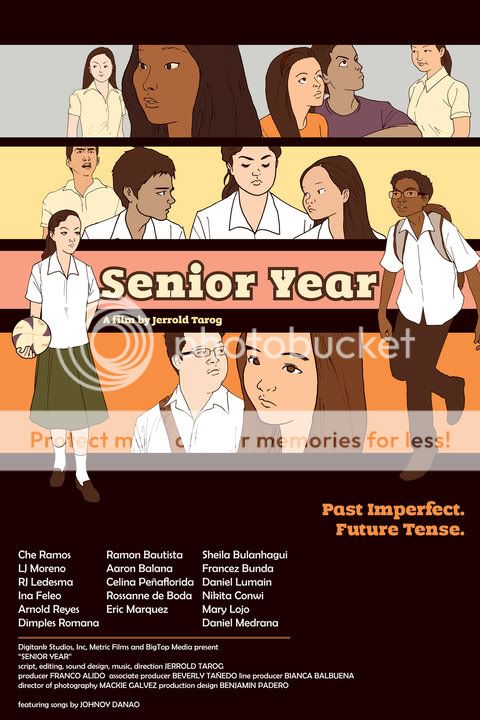 [Spoiler Alert: Reading this will spoil you. This is an in-depth analysis of the film and it talks about the specifics so be be wary of the information given here. Read with caution!]
[Spoiler Alert: Reading this will spoil you. This is an in-depth analysis of the film and it talks about the specifics so be be wary of the information given here. Read with caution!]Senior Year (2010) is Philippine independent cinema in a candy bar. Here is a film that touches so many issues that it somewhat collects the filmic conflicts of past ten years of Philippine independent film-making: homosexuality, infidelity, familial problems, coming-of-age, modernity, class consciousness, religious dogmatism, social awareness, drug addiction, crime and politics. Inspired by Jude Apatow's 1990s TV series entitled Freaks and Geeks and Lauren Cantet's placid The Class (2008) written similar to Mike Leigh's pre-production method, Senior Year is quite a bomb!
Some Notes on Form and Style
What strikes me the most, above all, is the way the film was pieced together. From the use of lens to the pans and tilts to the perpetual camera movements, the film proves to be technically dazzling, a bittersweet type of film we do not usually see in mainstream Philippine cinema lately. At one noticeable instant during a hallway scene, the artistic control of the camera is evident when the characters enters and exits the hallway similar to the order of a fashion show. The camera, adjusted in deep-focus, moves forward and backward in a glacially paced manner reminiscing the sort of cinematography Jean Renoir employed in La Grande Illusion (1937) and numerous other films which uses a continuously moving camera to reveal depth of the mise-en-scene and offscreen elements.
The lighting functions well enough it becomes an expressionistic tool giving each character both depth and abstraction. At one instance, when Carlo, the flamboyant gay character in the movie, phones Bundha, a noticeable change can be observed in the type of lighting used for each frame. From the bright lampshade of Carlo, it cuts away to an almost chiaroscuro low-contrast lighting on Bundha reflecting her state of mind. The frontal framing of Bundha's face followed by 180-degree-cut of her quarreling parents about her father's drug addiction problem exhumed some sort of abstraction wherein the audiences were oriented for its conceptual purpose more than its visual purpose. Or simply, this is a film the enables the viewers to think actively than passively, to participate in the thinking process not just to received it as it is. The scene, due to its lack of establishing shot, gave us cues as to what level of perception Jerrold Tarrog wants his audience to view the film, a high level of intelligence most of local mainstream films fails to achieve.
One can go on by saying that the artistic control Tarrog and his production team gave to the film played well with its entertainment value making it one of the few local films with an indie-mainstream conditioning, a trend that has become competitive with films produced by big producers such as Star Cinema and GMA Films for quite sometime now.
Tarog do have his own way of making a film. From his blog he notes that he did a series a acting workshop first before coming up with a screenplay and of course with the film similar to the style of Mike Leigh. He also let his actors improvised some of the scenes. The results is a semi-raw quality of film acting delivered in a quirky style both nuanced and seemingly controlled.
Thematic Richness
Aside from its aesthetics, Senior Year is one good example of the multifaceted film composed numerous sub-plots with an ensemble cast. The narrative structure follows other local films like Manila by Night (1980) and Jologs (2002) and foreign films like Magnolia (2005) and Crash (2004). Each main character is highlighted and deepened by providing filmic information about their family, dreams and conflicts. Each one is represented by their distinctive qualities., though at times may be succinctly dismissed as stereotypical traits. These qualities integrate into a comic collision of riot and laughter one cannot escape from its hilarity and be entertained. From the lesbian couple (Steph and some girl) bounded by the dogmatic religious teachings of her father to the drug addiction faced by Bundha to the abuse of the English teacher by her husband to the infidelity issues faced by the charismatic guy named Ian to the class-conscious student who owns a karenderia summarizes the richness of Philippine cinema for the past ten years thereby defining our present generation: the youth of 2000s.
Here is a film that, ten to fifteen years from now, will be remembered as a crowd's favorite, a film that reflects the young Filipino generation of the 2000s each of us will miss and will be constantly reminisced through the years.
Ciao!
****
Some Notes on Form and Style
What strikes me the most, above all, is the way the film was pieced together. From the use of lens to the pans and tilts to the perpetual camera movements, the film proves to be technically dazzling, a bittersweet type of film we do not usually see in mainstream Philippine cinema lately. At one noticeable instant during a hallway scene, the artistic control of the camera is evident when the characters enters and exits the hallway similar to the order of a fashion show. The camera, adjusted in deep-focus, moves forward and backward in a glacially paced manner reminiscing the sort of cinematography Jean Renoir employed in La Grande Illusion (1937) and numerous other films which uses a continuously moving camera to reveal depth of the mise-en-scene and offscreen elements.
The lighting functions well enough it becomes an expressionistic tool giving each character both depth and abstraction. At one instance, when Carlo, the flamboyant gay character in the movie, phones Bundha, a noticeable change can be observed in the type of lighting used for each frame. From the bright lampshade of Carlo, it cuts away to an almost chiaroscuro low-contrast lighting on Bundha reflecting her state of mind. The frontal framing of Bundha's face followed by 180-degree-cut of her quarreling parents about her father's drug addiction problem exhumed some sort of abstraction wherein the audiences were oriented for its conceptual purpose more than its visual purpose. Or simply, this is a film the enables the viewers to think actively than passively, to participate in the thinking process not just to received it as it is. The scene, due to its lack of establishing shot, gave us cues as to what level of perception Jerrold Tarrog wants his audience to view the film, a high level of intelligence most of local mainstream films fails to achieve.
One can go on by saying that the artistic control Tarrog and his production team gave to the film played well with its entertainment value making it one of the few local films with an indie-mainstream conditioning, a trend that has become competitive with films produced by big producers such as Star Cinema and GMA Films for quite sometime now.
Tarog do have his own way of making a film. From his blog he notes that he did a series a acting workshop first before coming up with a screenplay and of course with the film similar to the style of Mike Leigh. He also let his actors improvised some of the scenes. The results is a semi-raw quality of film acting delivered in a quirky style both nuanced and seemingly controlled.
Thematic Richness
Aside from its aesthetics, Senior Year is one good example of the multifaceted film composed numerous sub-plots with an ensemble cast. The narrative structure follows other local films like Manila by Night (1980) and Jologs (2002) and foreign films like Magnolia (2005) and Crash (2004). Each main character is highlighted and deepened by providing filmic information about their family, dreams and conflicts. Each one is represented by their distinctive qualities., though at times may be succinctly dismissed as stereotypical traits. These qualities integrate into a comic collision of riot and laughter one cannot escape from its hilarity and be entertained. From the lesbian couple (Steph and some girl) bounded by the dogmatic religious teachings of her father to the drug addiction faced by Bundha to the abuse of the English teacher by her husband to the infidelity issues faced by the charismatic guy named Ian to the class-conscious student who owns a karenderia summarizes the richness of Philippine cinema for the past ten years thereby defining our present generation: the youth of 2000s.
Here is a film that, ten to fifteen years from now, will be remembered as a crowd's favorite, a film that reflects the young Filipino generation of the 2000s each of us will miss and will be constantly reminisced through the years.
Ciao!
****


